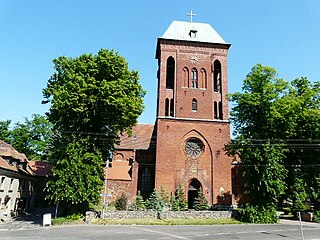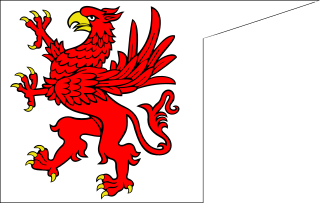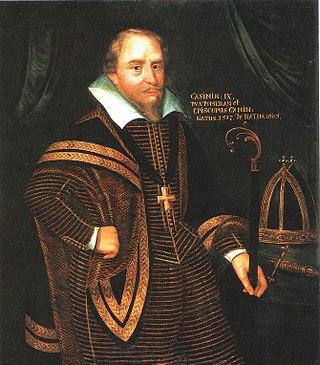Related Research Articles

The Duchy of Pomerania was a duchy in Pomerania on the southern coast of the Baltic Sea, ruled by dukes of the House of Pomerania (Griffins). The country existed in the Middle Ages between years 1121–1160, 1264–1295, 1478–1531, and 1625–1637.

The House of Griffin or Griffin dynasty was a dynasty ruling the Duchy of Pomerania from the 12th century until 1637. The name "Griffins" was used by the dynasty after the 15th century and had been taken from the ducal coat of arms. Duke Wartislaw I was the first historical ruler of the Duchy of Pomerania and the founder of the Griffin dynasty. The most prominent Griffin was Eric of Pomerania, who became king of the Kalmar Union in 1397, thus ruling Denmark, Sweden and Norway. The last Griffin duke of Pomerania was Bogislaw XIV, who died during the Thirty Years' War, which led to the division of Pomerania between Brandenburg-Prussia, Sweden and Poland. Duchess Anna von Croy, daughter of Duke Bogislaw XIII and the last Griffin, died in 1660.

Anna of Pomerania was Duchess-Consort of Croy and Havré, and allodial heiress of the extinct ducal house of Pomerania.

The Bishopric of Cammin was both a former Roman Catholic diocese in the Duchy of Pomerania from 1140 to 1544, and a secular territory of the Holy Roman Empire (Prince-Bishopric) in the Kołobrzeg area from 1248 to 1650.

Bogusław I, a member of the House of Griffin, was Duke of Pomerania from 1156 until his death. In 1181 he received the "Duchy of Slavinia" as a fief from Emperor Frederick Barbarossa.
Adalbert of Pomerania was the first bishop of the 12th century Pomeranian bishopric, with its see in Wolin. He was a monk of the Michaelsberg Abbey, Bamberg and former chaplain to Bolesław III Wrymouth of Poland, whence he knew the Pomeranian language of the temporarily Polish-subjugated West Slavic population, whereas the Joms Vikings and other Germanic inhabitants of the Pomeranian coast understood his old German language.

The Schlawe and Stolp Land, also known as Słupsk and Sławno Land, is a historical region in Pomerania, centered on the towns of Sławno (Schlawe) and Słupsk (Stolp) in Farther Pomerania, in present-day Poland.

The Duchy of Pomerania-Wolgast, also known as the Duchy of Wolgast, and the Duchy of Wołogoszcz, was a feudal duchy in Western Pomerania within the Holy Roman Empire. Its capital was Wolgast. It was ruled by the Griffin dynasty. It existed in the Late Middle Ages era from 1295 to 1478.

The Duchy of Pomerania-Stettin, also known as the Duchy of Stettin, and the Duchy of Szczecin, was a feudal duchy in Farther Pomerania within the Holy Roman Empire. Its capital was Szczecin. It was ruled by the Griffin dynasty. It existed in the eras of the High and Late Middle Ages, and the early modern period, between 1160 and 1264, between 1295 and 1523, and between 1532 and 1625.

The Duchy of Pomerania-Stolp, also known as the Duchy of Stolp, and the Duchy of Słupsk, was a feudal duchy in Farther Pomerania. Its capital was Słupsk. It was ruled by the Griffin dynasty. It existed in the High Middle Ages era from 1368 to 1478.

Bogisław VIII, a member of the House of Griffin, was Duke of Pomerania ruling in Pomerania-Stolp from 1395 until his death. He also served as administrator of the Prince-Bishopric of Cammin from 1387 and as Cammin Prince-bishop from 1394 to 1398.

Wartislaw V. was a duke of Pomerania from the House of Griffin. He initially ruled Pomerania-Wolgast jointly with his elder brothers Barnim IV and Bogislaw V. He stood in their shadow and after 1368, he ruled his own part of the Duchy: the Land of Neustettin. Neustettin is now called Szczecinek.

Philip II, Duke of Pomerania-Stettin was from 1606 to 1618 the reigning duke of Pomerania-Stettin and is considered to be among of the most artistic of the Pomeranian dukes. He married Sophia of Schleswig-Holstein-Sonderburg in 1607. The marriage remained childless.

Duke Ulrich of Pomerania, was a Lutheran administrator of the Prince-Bishopric of Cammin and non-reigning Duke of Pomerania.

Bogislaw VII was a Duke of Pomerania-Stettin from the House of Griffin.

Elisabeth of Schleswig-Holstein-Sonderburg was a German noblewoman. She was a Duchess of Schleswig-Holstein-Sonderburg by birth and by marriage Duchess of Pomerania-Stettin.

The Duchy of Pomerania-Stargard, also known as the Duchy of Stargard located in Western Pomerania in the Holy Roman Empire, was a feudal duchy with its capital in Stargard. It was formed in 1377, when it separated from Pomerania-Stolp. In 1395, it fell under the control of the Duke of Pomerania-Stolp, and continued to be ruled by the successive Dukes of the House of Griffins until its dissolution in 1478, when it was incorporated into a unified Duchy of Pomerania.
The Duchy of Pomerania-Schlawe, also known as the Duchy of Sławno, was a feudal duchy with its capital in Sławno, located in Pomerania. It was formed in 1190, when it separated from the Duchy of Szczecin. In 1238 it was conquered and incorporated into the Duchy of Gdańsk.
The Duchy of Pomerania-Demmin, also known as the Duchy of Demmin, and the Duchy of Dymin, was a feudal duchy in Western Pomerania within the Holy Roman Empire. Its capital was Demmin. It was ruled by the Griffin dynasty. It existed in the High Middle Ages era, between 1160 and 1264.
The Duchy of Pomerania-Rügenwalde, also known as the Duchy of Rügenwalde, and the Duchy of Darłowo, was a feudal duchy in Western Pomerania within the Holy Roman Empire. Its capital was Darłowo. It was ruled by the Griffin dynasty. It existed in the early modern period, from 1569 to 1625.